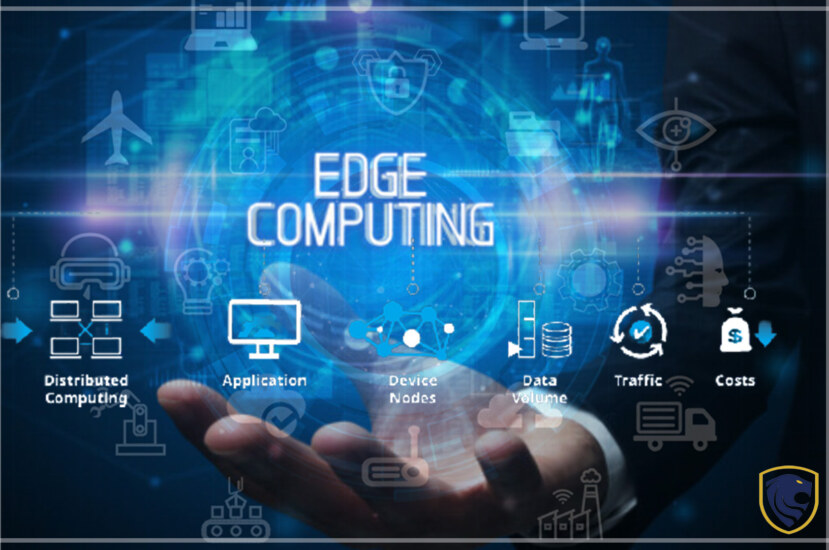Edge computing is an emerging concept in the IT world. It refers to the use of cloud computing technologies at the edge of a network, thus bridging the gap between centralized computing power and distributed systems. Edges are used not only for device-to-device communication and peer-to-peer (P2P) interactions in emerging mesh networks but also as a bridge between centralized infrastructure and autonomous devices. This article presents an overview of recent developments in edge computing, shares examples from different fields, presents possible applications of this technology, discusses its limitations and future prospects, and comprehensively addresses key aspects of edge networking using application scenarios to show where it can be used.
Cloud computing
Cloud computing allows users to buy, sell and use processing power as a service. It is based on the elastic model of computing, in which a provider offers an infrastructure platform. That is accessible through external networks and virtualization technologies. When cloud computing first appeared as an example of IaaS (Infrastructure-as-a-Service), conventional providers were offering physical resources such as servers with installed software packages to customers via network protocols for use over the Internet or private networks.
In the cloud computing scenario, the provider’s hardware is no longer physically installed in its own data center but provides access to resources that are already running on a network. In this model, users do not have to buy or maintain their own hardware; they buy subscriptions from the provider, which implies purchasing a virtualized computing platform.
Compared with conventional server farms and virtual machines, cloud computing brings new challenges related to data synchronization, data management, and access control. This type of service is often referred to as Edge Computing.

Cloud computing
Edge computing
In short, edge computing is nothing but a computing model which handles processing at the edges of infrastructure, i.e., within local networks, to minimize data transfer costs and maximize work execution efficiency. In this model, edge computing not only facilitates the movement of data between the cloud and endpoints but also performs some final calculations for end-usage applications based on the needed parameters (e.g., location, distance from nearby nodes). These computations can be done efficiently in real-time or near real-time at the edge of networks without depending on centralized cloud resources.
As an example, consider a phone with GPS-enabled mobile applications that support external cloud services. In this case, the application is responsible for processing the data received from the cloud. Thus saving the standard server resources such as CPUs and memory and communicating with the cloud servers only when necessary. The greater part of these processes are executed locally. (E.g., computation of weather information). In real-time or near real-time at the edge of networks without depending on centralized cloud resources.
In this context, the term “edge” can be understood as not referring to a physical location in terms of latitude and longitude. But rather adjacent to some peripheral devices such as sensors in IoT applications or smart appliances. In this case, the edge systems process the data received from sensors and execute local logic. (I.e., edge logic) For proceeding with further actions. Some of these actions are often non-trivial in nature.

Edge computing
fog computing
This model is also described as “fog computing.” Like the term “fog” in meteorology, which describes air immediately above the Earth’s surface. Fog computing refers to a model that utilizes computing resources within a given area. (E.g., a city block or a group of buildings.) Or connected by short-range wireless links. In contrast to conventional cloud computing, where connections are made between servers located at distinct physical locations. (E.g., in different cloud data centers). Fog computing does not need access to centralized servers. Instead, it uses local resources such as field-programmable gate array (FPGA) chips.
In the context of edge computing, “edge logic” refers to logic performed in local networks or near-field communication at endpoints, which is executed on a device connected to the network. This local processing is usually less expensive than using centralized cloud resources and more efficient than communicating with remote servers.
In some cases, edge logic can be run on a device that is specifically deployed for use in edge computing. More commonly, however, edge logic is executed on a general purpose device connected to the network. (Such as a tablet or desktop computer). In this case, the application performs computations directly on data it has gathered from nearby devices or other local sources. Computational capacity and Internet connectivity are only required when data has to be communicated with distant servers.
Edge computing is an emerging concept that continues to experience advances in its development and implementation. It can be used in a wide range of applications to optimize resource utilization, efficiency, and manageability. In this article, we will focus on its application in IoT (Internet of Things), which is a collection of connected physical devices that collect and transfer data.

fog computing
Relationship between edge computing and IoT
Edge computing has become an important topic for Internet of Things (IoT)-related applications, as the power consumption of connected devices has continued to rise. Data collected from a set of IoT-related applications show an increase in the use of edge computing. (Such as smart home appliances, wearable devices, and cars). For example, consumers are adopting IoT-related appliances more often than ever before because they are more convenient and energy efficient. Smart home technologies have been discussed in different areas such as energy management, music entertainment, and security. The high demand for this type of application has pushed the development of new edge and cloud computing techniques.
These techniques are a definition of the concept of edge computing. Instead of transferring data over long distances to centralized servers, they are processed locally at the edge gateways in IoT networks. These gateways can be deployed as near-field or remote sensors. They collect data and transfer it to the core network by means of Internet access points or as servers that can process sensor data directly using fast communication channels. The important point is that this model helps reduce the amount of data transmitted to the central server. Thus improving network performance and reducing communication costs.
management of data
Another important issue in IoT is the management of data. The data from various connected devices can be well managed in edge computing, as the system can create a new type of autonomous nodes that can manage themselves and their own data. For example, the concept of home automation has been developed to allow users to control their home appliances through smartphones.
However, to improve convenience, users must connect their smartphones with different devices. (E.g., thermostats) at different points within the network. Such as smart plugs or smart locks. In this case, many devices are required at each point where they are connected with these appliances. A user cannot efficiently manage all these elements independently from one another without proper procedures and tools for this purpose.



